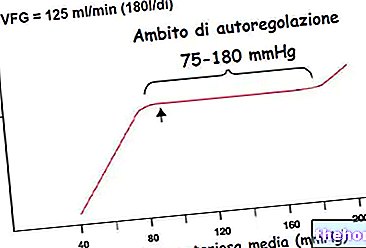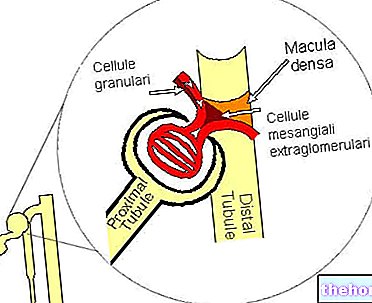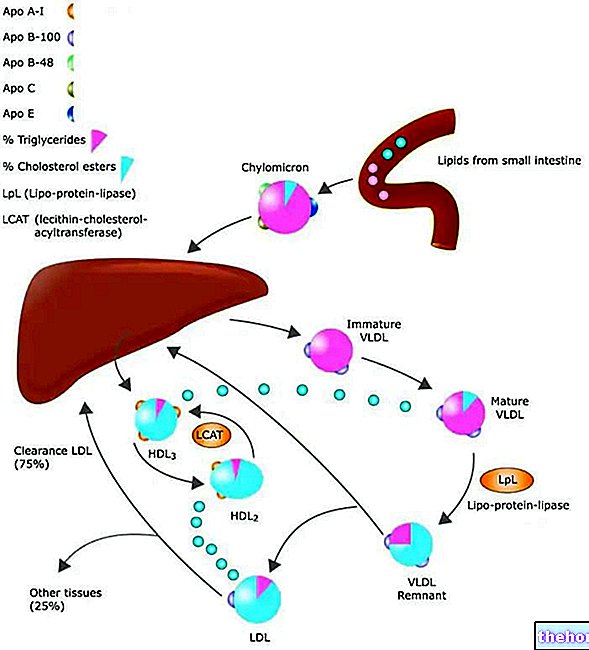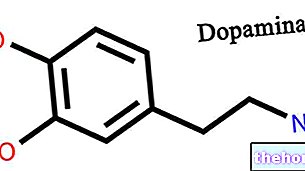What influences arteriolar resistance and glomerular filtration rate?
The control of resistance opposed by afferent and efferent arterioles to the renal glomerulus depends on numerous factors, both systemic and local.
The self-regulation of the glomerular filtration rate involves several mechanisms intrinsic to the nephron, among which we remember:
- the myogenic response: intrinsic ability of vascular smooth muscle to respond to changes in pressure.
If stretched by the systemic pressure increase, the smooth muscle of the afferent arterioles responds by contracting; in this way the resistance to flow increases by reducing the amount of blood that crosses the arteriole and with it the hydrostatic pressure exerted on the walls of the glomerular capillaries → is reduced the filtration rate.
Conversely, if systemic arterial pressure decreases, the arteriolar muscle relaxes and the vessel dilates maximally; in this way the blood flow inside the glomerulus increases and with it also the glomerular hydrostatic pressure and the filtration rate increase. However, it should be noted that vasodilation is not as effective as vasoconstriction, since in normal conditions the afferent arteriole is already quite dilated. It allows the myogenic response to compensate for the increase in systemic arterial pressure well, and a little less well for its possible decrease.
If the mean blood pressure falls below 80 mmHg, the glomerular filtration rate decreases; if we think that blood pressure can drop massively as a result of severe dehydration or haemorrhage, this mechanism of reduction of GF allows to reduce as much as possible the amount of fluids lost in the urine, helping the conservation of blood volume
- tubulo-glomerular feedback: changes in the flow of the liquid that crosses the final stretch of the loop of Henle and the initial stretch of the distal tubule influence the glomerular velocity. In the loop of Henle, processes of reabsorption of water and sodium and chloride ions take place . The particular folded structure of the nephron causes the final portion of the "loop of Henle to pass between the afferent and efferent arterioles of the renal glomerulus. In this region, a structural and functional relationship is established between the two structures so as to constitute a real" apparatus "defined" juxtaglomerular apparatus. Where they come into contact, both the arteriolar walls and those of the tubule have a modified structure that allows them to influence each other. In particular, the modified tubular structure is made up of a plate of cells called macula densa, while the adjacent wall of the afferent arteriole contains specialized smooth muscle cells, called granular (or juxtaglomerular or JG) cells. The latter secrete renin, a proteolytic hormone. involved in the salt and water balance, with hypertensive effects.

When the cells of the macula densa pick up an increase in the quantity of sodium chloride (expression of an increase in GFR) they signal to the granular cells to reduce the secretion of renin and to contract the afferent arteriole. This increases the resistance to flow offered. from the afferent arteriole and the hydrostatic pressure of the blood downstream, ie in the glomerulus, decreases together with the GFR. In the opposite condition, that is, in the event of a reduction in the NaCl concentration at the level of the terminal tract of the loop of Henle, the cells of the macula densa signal to the granular cells to increase the amount of renin, and to the afferent arteriole to dilate, reducing its own resistances; consequently there is an increase in the glomerular filtration rate.
Resistance control of afferent and efferent arterioles is also regulated by systemic factors. On the other hand, one of the main functions of the kidney is to regulate systemic blood pressure, so it is important that the glomeruli acknowledge any changes in systemic blood pressure and adjust the GF accordingly. These changes are transmitted to the kidney via the endocrine and nervous.
Nervous control of VFG is entrusted to sympathetic neurons that innervate both the afferent and efferent arterioles. Sympathetic stimulation, mediated by the release of adrenaline, causes vasoconstriction, especially of the afferent arteriole. Consequently, a strong sympathetic activation, resulting for example from heavy bleeding or severe dehydration, causes a contraction of the afferent and efferent arterioles to the glomeruli, reducing both the glomerular filtration rate and the blood flow to the kidneys. In this way we try to conserve the water volume as much as possible.
The endocrine control of GFR is entrusted to various hormones. In addition to circulating adrenaline, whose vasoconstrictive effects have just been described, arteriolar resistance is also increased by angiotensin II. However, in the latter case, the vasoconstriction mainly concerns the efferent arterioles, so the increase in pressure in the glomerular capillaries increases the glomerular filtration rate. Among the vasodilating substances that oppose the vasoconstrictor effect of the sympathetic nervous system and of angiotensin II, we recall some prostaglandins (PGE2, PGI2, Bradykinin), which reduce the resistance to flow offered above all by the afferent arterioles. This results in an increase in the glomerular filtration rate. Nitric oxide also exerts a vasodilating action at the arteriolar level.
The endocrine action is carried out at the level of the podocytes or mesangial cells. The contraction or relaxation of the latter, which we remember to be located in the spaces surrounding the capillaries of the renal glomeruli, modifies the area of the capillary surface available for filtration. Podocytes, on the other hand, modify the size of the glomerular filtration slits; if these widen, the filtration surface increases, therefore the glomerular filtration rate also increases.
Watch the video
- Watch the video on youtube
Other articles on "Regulation of glomerular arterial resistance"
- Glomerular Filtration - Filtration rate
- Kidney kidneys
- Kidney and glucose reabsorption
- Kidney and salt and water balance
- Nephron
- Renal glomerulus











.jpg)


















